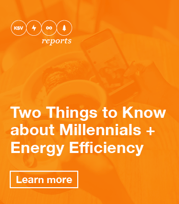The energy efficiency industry is ripe with opportunities.
To connect with customers.
To create a message with one clear voice.
Yesterday we presented an E Source webinar with our partner Lori Acker from National Grid on why creative testing matters.
At KSV we know the only way to get customers to take action is to create seamless advertising across all programs that resonates with them.

Energy efficiencies biggest failure, and opportunity, is tied to how products and services are framed and sold to customers, and the only way that this re-framing will work is if the way it is marketed breaks through to customers.
Creative testing is what can bridge the gap between what you think and what your customers want.
“Despite an estimated $279 billion potential U.S. market for energy efficiency, just a fraction of this has been spent. The industry’s greatest failure, arguably, is tied to how products and services are framed and sold to customers.”
GreenTech Media also reports that, “efficiency upgrades and technologies have seen remarkably low market penetration considering the simple value proposition: cut energy use and save money.”
It’s worth reiterating the statement, “The industry’s greatest failure, arguably, is tied to how products and services are framed and sold to customers.”
When it comes to appliances, technology and products, energy efficiency is, for the most part, positioned as one of the many product features. (While it’s an important one, it’s just a piece of the larger offering.)
When it comes to utility services and programs, for the most part the message is: Lower your bill through energy savings. In addition, marketing energy efficiency programs and offers is typically just a piece of the larger marketing plan. There are other programs and messages that are being sent out. So, while it’s an increasingly bigger part of the customer conversation, in many cases, it’s still separated from the strategic brand communications platform.
Energy efficiency for too long has been defined by a lower bill, or financial savings. If you think about it, the industry has essentially been framing the subject as a discount coupon for your energy bill.
Neither of these situations are “failures.” But there’s an opportunity for brands to leverage energy efficiency (and the investment they’re putting in) and make it work harder for them.
Consumers want to support brands that are making an impact beyond profit, sales and technology. Especially the rising Millennials, who in 10 years will make up 75% of the workforce.
People are surrounded by an endless sea of content. If you want your message and brand to rise to the top, chances are you are going to have to take a stand. You will have to be relevant, both where the consumer is paying attention and on what actually matters to them.
According to Trendwatching, 73% of Millennials believe businesses should share a point of view about issues and should influence others to get involved. Many consumers believe brands should speak out to stand out.
We’re not saying you need to put out an op-ed on the Iran nuclear deal, but we are saying that you need to take a stand on something that actually matters to consumers.
This is the gift of energy efficiency.
Whether you know it or not, you have already taken a stand. Whether it was forced, mandated or an outcome of your culture, it really doesn’t matter. If you offer energy efficiency programs or products, this is already proof that you’re taking action for a more sustainable future and a higher quality product… and if your customers join you, they can make an impact too.
Why isn’t energy efficiency representing the brand of every utility? Why aren’t we leveraging energy efficiency to be less of a feature, and more of an empowered choice in the shopping and renovations process?
Energy efficiency has the opportunity of being framed within your brand – to enhance your brand value to your customer, and your market influence.
Before we can expect the financial savings to inspire long term action, we have to build the customer’s desire to participate. Simply offering rebates and program sign-ups does not paint the picture of taking a stand, nor does it create a long-term desire for energy efficiency. It’s actually just adding another offer to the sea of sales your customer is faced with everyday, if it’s not framed correctly.
Step 1: Inspire customers to WANT to participate. Build awareness of your efforts to offer cleaner, more efficient product and service, and tie that to the benefits and objectives of your customers.
Step 2: Deliver the rational offers and rebates that make it easy to purchase and/or participate in these products and services.
Let’s get the return on that $279 billion. It might just be your power ball. (With better odds, of course.)

